#red dwarf advent
Explore tagged Tumblr posts
Text
Advent 8: Snow
Kryten was examining a Christmas card sent to Hollister by one of his many secret children long, long ago. It wasn't very imaginative. Just a standard robin standing on snowy log. But to Kryten, it was a novel image.
'I've never seen a robin,' he said longingly. 'And the first time I ever saw snow was when Cat and I came to rescue you and Mr Rimmer from that frozen planet.'
'And there was too much of it there,' smiled Lister. 'Never mind, Kryts, one day we'll find another Earth with gardens and birds and the proper amount of snow every winter.'
'It was my first time too, bud,' said the Cat. 'No snow on the Dwarf. My outfit was on point, though.'
'And it was my first time,' added Rimmer. 'I didn't like it much.'
'Guys, are you serious?' said Lister. 'You've never built a snowman, been in a snowball fight? Never told a younger kid to eat yellow snow because it tastes like a lemon ice lolly?' He lent back in his chair. 'All this time I've been travelling with a bunch of snow virgins.'
'It's not our fault!' snapped Rimmer. 'We just grew up on the wrong moon and in the wrong time periods.'
Lister put on a posh voice. 'Not to worry, my dear friends. Come join me in the virtual world tonight. I have a cold surprise for you.'
Rimmer shook his head. 'No.'
'Oh c'mon, don't be a spoil sport. Don't you want to get drunk, fall over and make a snow angel?' Lister lent over Rimmer's chair, pushing his face close to Rimmer's. 'You can cuddle up to me to keep warm. Go on, go on, Arn, say yes!'
'Ugh. Fine, fine! Just back off, you have morning curry and larger breath!'
'I'll come too,' said the Cat. 'Just let me change my clothes.'
'I'm coming too,' said Kryten. 'I want to try tobogganing.'
'That's the spirit, guys!'
15 notes
·
View notes
Text
That "e" can have consequences!
youtube

91 notes
·
View notes
Text
Welcome to Revenge of the Underrated!
Some of you asked me to put a "haven't watched both" to be more fair to the more unknown movies, but I've seen other tournaments doing this and I think it limits too much who can participate in the polls. So what I decided to do is a double elimination!
What does that mean? That means a movie has to lose twice to be eliminated. In other words, there will be a sorts of losers bracket that'll be part of main bracket. I'm undecided on whether to do this for only one round or the whole bracket, as it would make the tournament very long. Do let me know if you have any opinion about it.
Anyway, Revenge of the Underrated, Round 1:
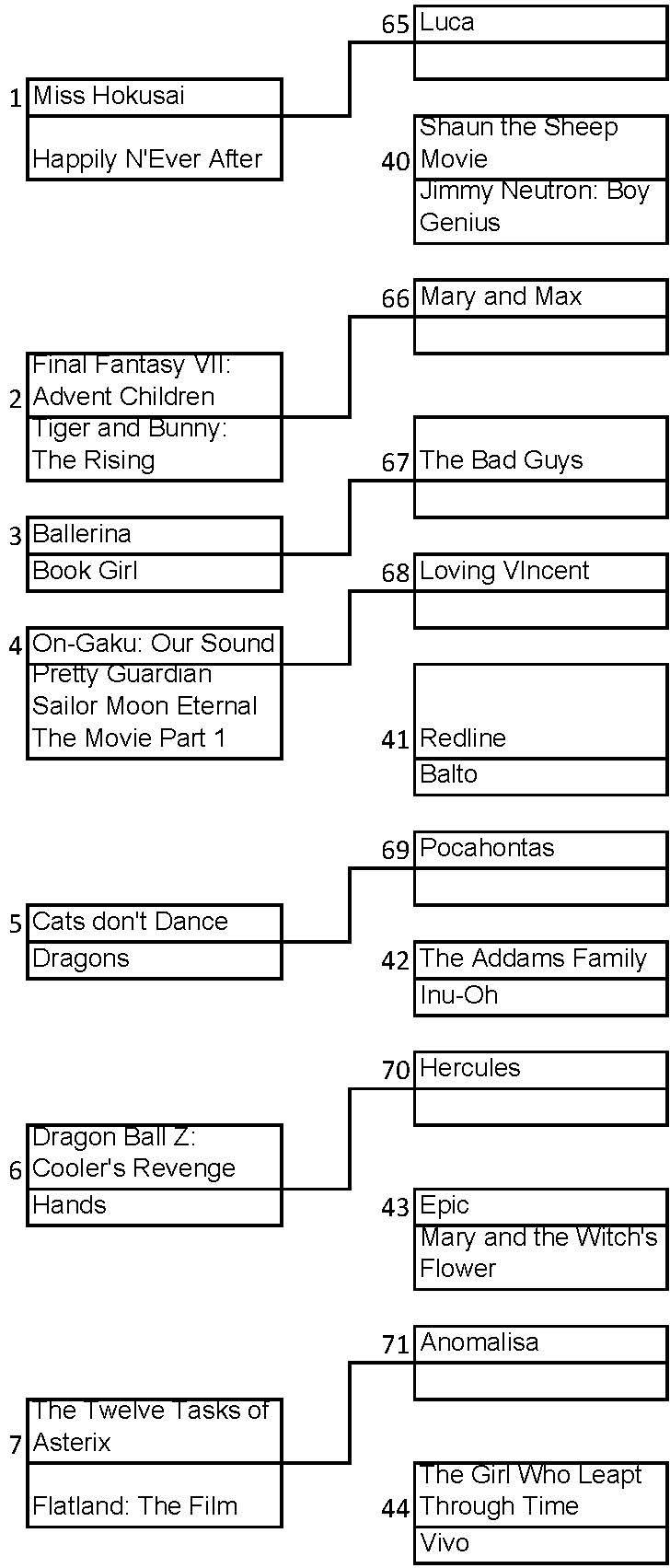

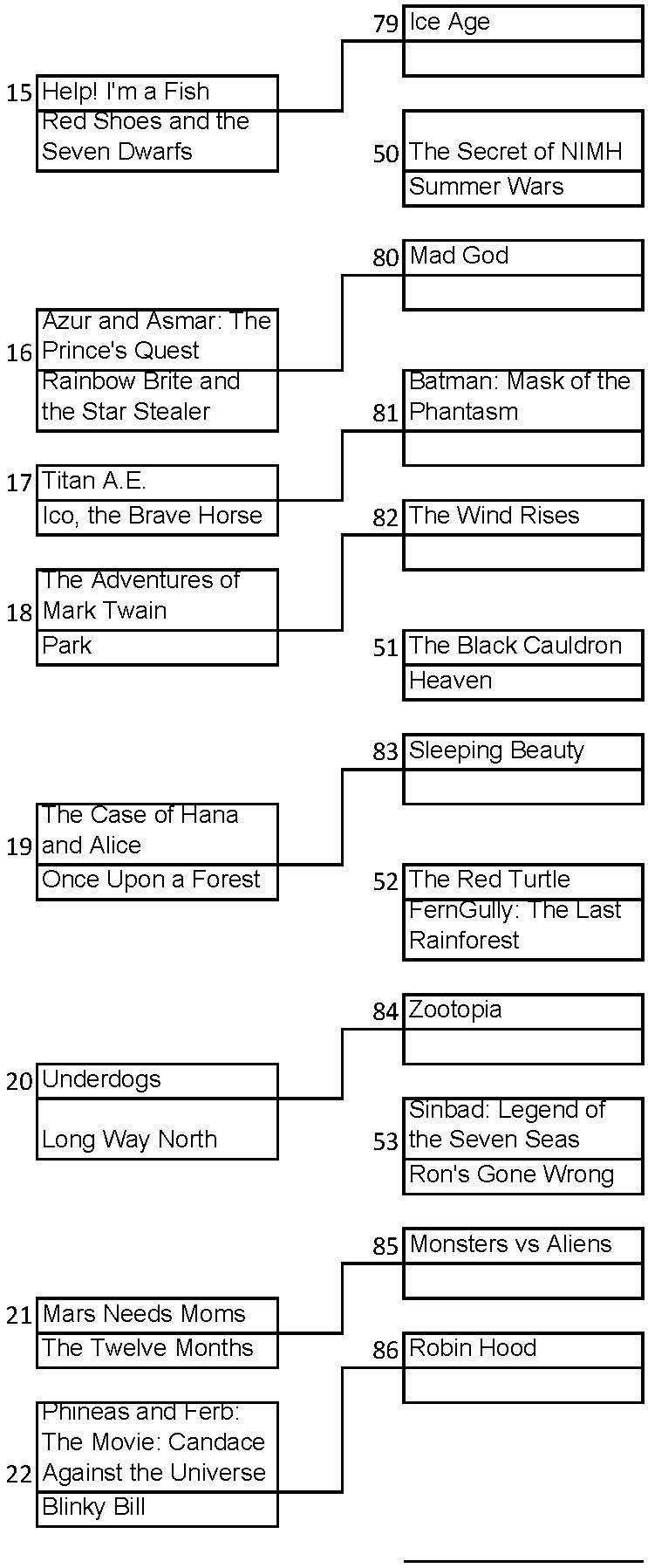
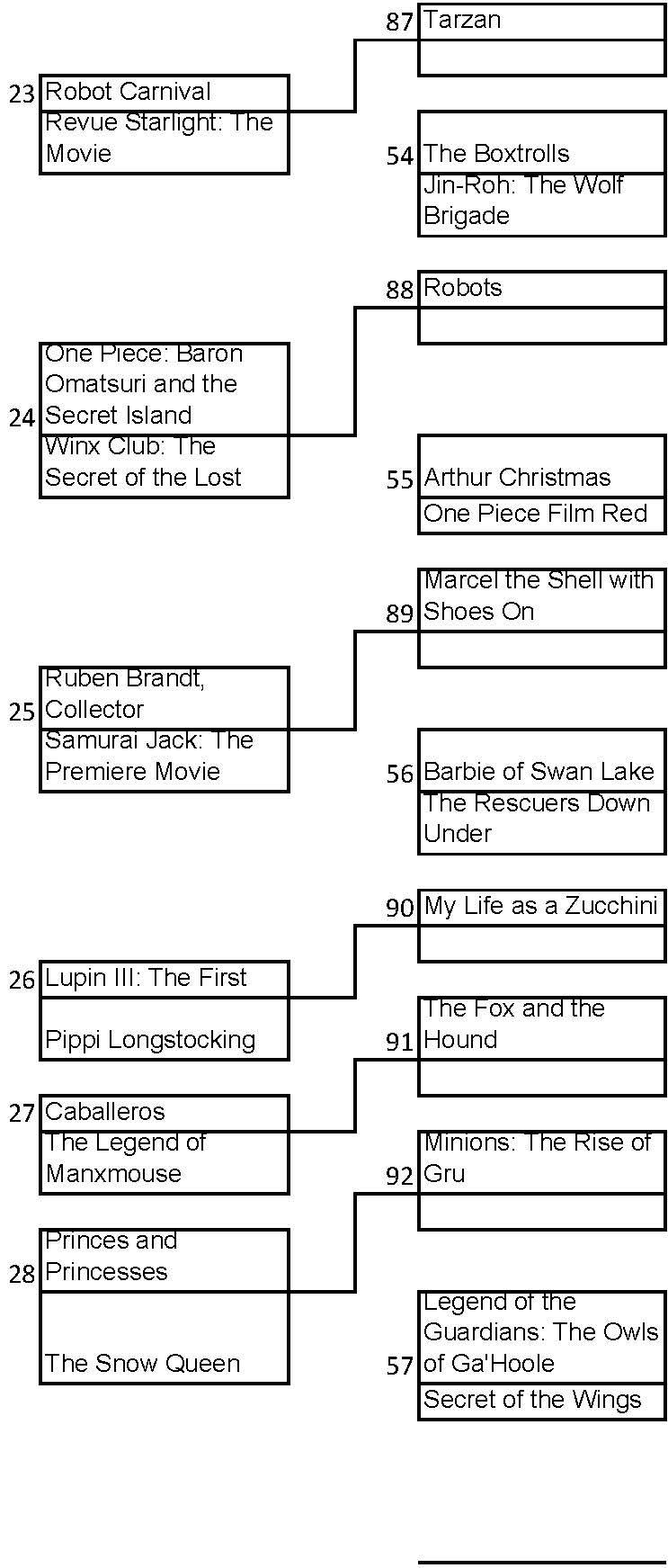
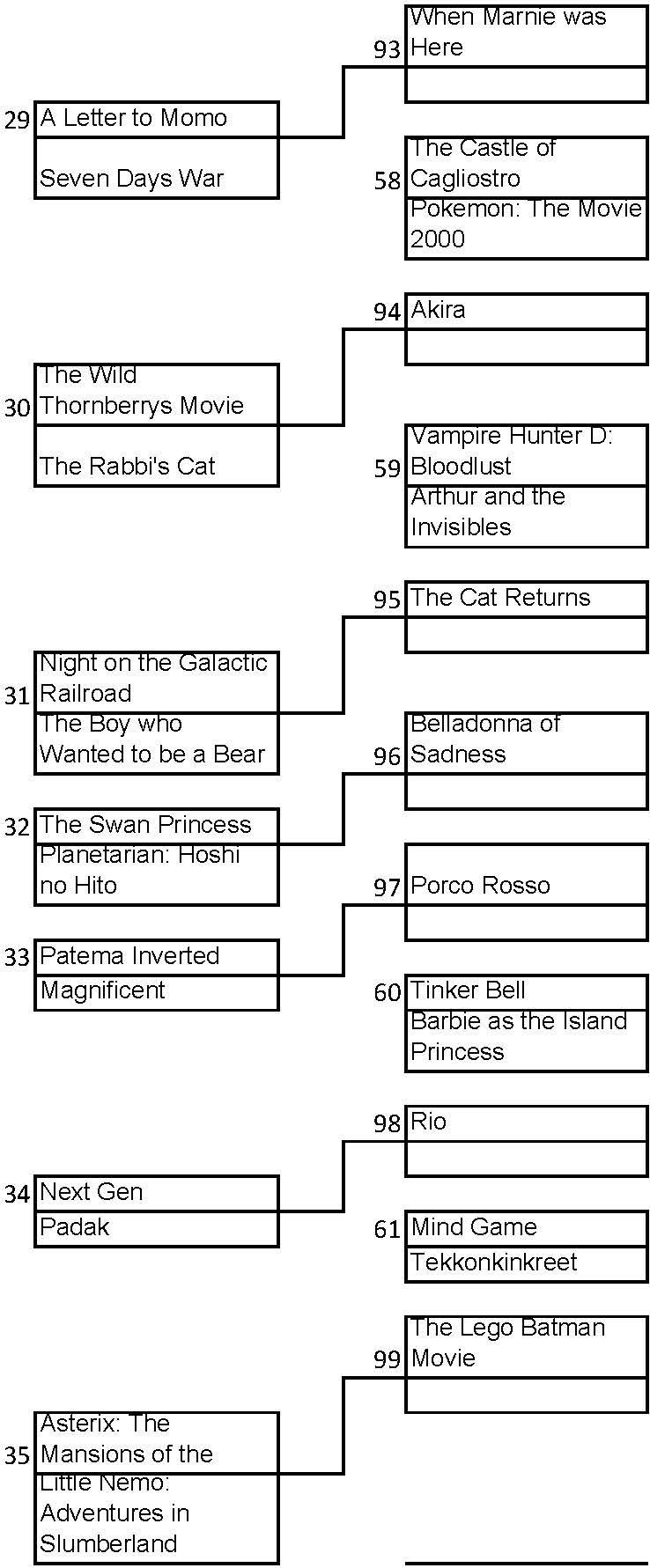

Miss Hokusai vs Happily N'Ever After
Final Fantasy VII: Advent Children vs Tiger and Bunny: The Rising
Ballerina vs Book Girl
On-Gaku: Our Sound vs Pretty Guardian Sailor Moon Eternal The Movie Part 1
Cats don't Dance vs The Flight of Dragons
Dragon Ball Z: Cooler's Revenge vs The Girl Without Hands
The Twelve Tasks of Asterix vs Flatland: The Film
Felidae vs Pokemon the Movie: The Power of Us
An American Tail: Fievel Goes West vs Unico in the Island of Magic
Rock and Rule vs Rock-A-Doodle
The Little Mermaid: Ariel's Beginning vs Freddie as F.R.0.7
The Plague Dogs vs The Magic Riddle
Pokemon Heroes vs The Pebble and the Penguin
Strange Magic vs Sea Prince and the Fire Child
Help! I'm a Fish vs Red Shoes and the Seven Dwarfs
16.Azur and Asmar: The Prince's Quest vs Rainbow Brite and the Star Stealer
17.Titan A.E. vs Ico, the Brave Horse
18.The Adventures of Mark Twain vs A Troll in Central Park
19.The Case of Hana and Alice vs Once Upon a Forest
20.Underdogs vs Long Way North
21.Mars Needs Moms vs The Twelve Months
22.Phineas and Ferb: The Movie: Candace Against the Universe vs Blinky Bill
23.Robot Carnival vs Revue Starlight: The Movie
24.One Piece: Baron Omatsuri and the Secret Island vs Winx Club: The Secret of the Lost Kingdom
25.Ruben Brandt, Collector vs Samurai Jack: The Premiere Movie
26.Lupin III: The First vs Pippi Longstocking
27.The Three Caballeros vs The Legend of Manxmouse
28.Princes and Princesses vs The Snow Queen
29.A Letter to Momo vs Seven Days War
30.The Wild Thornberrys Movie vs The Rabbi's Cat
31.Night on the Galactic Railroad vs The Boy who Wanted to be a Bear
32.The Swan Princess vs Planetarian: Hoshi no Hito
33.Patema Inverted vs Bartok the Magnificent
34.Next Gen vs Padak
35.Asterix: The Mansions of the Gods vs Little Nemo: Adventures in Slumberland
36.Thumbelina vs Catnapped!
37.Early Man vs Rainbow Magic: Return to Rainspell Island
38.Junk Head vs Hey Arnold! The Jungle Movie
39.Charlotte's Web (1973) vs The Princess and the Goblin
40.Shaun the Sheep Movie vs Jimmy Neutron: Boy Genius
41. Redline vs Balto
42. The Addams Family vs Inu-Oh
43. Epic vs Mary and the Witch's Flower
44.The Girl Who Leapt Through Time vs Vivo
45.Barbie: Princess Charm School vs Kronk''s New Groove
46.Waking Life vs The Transformers: The Movie
47.Barbie in the Nutcracker vs Barbie as Rapunzel
48.Pokemon: The First Movie - Mewtwo Strikes Back vs Cool World
49.The Land Before Time vs When the Wind Blows
50.The Secret of NIMH vs Summer Wars
51.The Black Cauldron vs All Dogs go to Heaven
52.The Red Turtle vs FernGully: The Last Rainforest
53.Sinbad: Legend of the Seven Seas vs Ron's Gone Wrong
54.The Boxtrolls vs Jin-Roh: The Wolf Brigade
55.Arthur Christmas vs One Piece Film Red
56.Barbie of Swan Lake vs The Rescuers Down Under
57.Legend of the Guardians: The Owls of Ga'Hoole vs Secret of the Wings
58.The Castle of Cagliostro vs Pokemon: The Movie 2000
59.Vampire Hunter D: Bloodlust vs Arthur and the Invisibles
60.Tinker Bell vs Barbie as the Island Princess
61.Mind Game vs Tekkonkinkreet
62.The Many Adventures of Winnie the Pooh vs Dragon Ball Super: Broly
63.Mirai vs Dragon Ball Super: Super Hero
64.The Lion King II: Simba's Pride vs Scooby-Doo! and the Cyber Chase
27 notes
·
View notes
Text
Dungeon Meshi Chapter 22
I was looking forward to the party facing the dragon, but I'm happy with learning more about the world instead.
So this takes place on an island with a single port city. And underneath the island is an ancient kingdom. The spectre from chapter 1 said the kingdom was sealed beneath the earth. That makes me think that the surrounding lands were either buried under the earth or the surrounding land was raised up to bury the golden city. Either way, the "island" is probably just the top-most point of the seal on the dungeon and the water is either ocean water that flooded in or 1,000 years worth of rainfall.
Calling it "the island" and giving it a backstory of "it had so many names from so many races that calling it the island is less confusing" is such a cheeky thing to do. It's the kind of thing a DM would do when they just want to do a dungeon-crawl adventure.
I want to know what that looks like on the other end.

Judging by the angle, the portal on the other side was against the ground, so it probably feels like crawling through a slightly too-small hole. Kiki was awkward walking through since she had to duck to fit through the portal but also had to avoid falling when stepping out of it.
There were some other painted canvases as well. Probably from previous journeys. The next question is whether that teleportation spell is two-way or not.

Namari didn't handle the trip well at all. Is it a dwarf thing that they get sick from magic effects, or is it something like motion or altitude sickness?

The Tansus are well off enough that they seem to have servants.
GOATS!! I love goats!

More talk about the dungeon becoming more dangerous. It was a closed-off environment for 1,000 years. Then it was discovered and adventurers started exploring it, killing the monsters, and taking any riches they could find. If the mage is trying to preserve the kingdom, it would make sense for him to ramp up the danger to keep adventurers from going further in.
Okay, so the chapter does give some backstory to the island. There was a war on it between elves and dwarfs. Some people believe the dungeon was the result of dwarfs digging so much that it sank the golden city underground. Mr Tansu says that idea isn't credible. What he didn't say is that it's just racism.
I wonder if this war ties in any way to what the Orc chieftain said back in chapter 9. Orcs used to live above ground, according to the chief, but were driven underground by humans and elves. Maybe Orcs fought in the war on the side of the dwarfs and Tallmen fought alongside elves.
Granted, considering Tallmen, Elves, and Dwarfs seem to be living in general peace, but Orcs are still pariahs, maybe these are two different things.
Mr Tansu used the term "human" when talking about the magic runes but "Tallman" gets mentioned later. So "human" is a technical term in this world. I'm going to guess that Tallmen and Half-foots are both classified as "human".
And there's a whole society of Western Elves. This land was previously Dwarven territory that the Elves took and granted to humans.

There's definitely about to be a race war at some point. The Elf King wants to claim complete ownership over the dungeon because they owned it at some point and gave it to the humans.
They probably thought the island was worthless because it's away from other locations and didn't have any obvious utility. Then the moment something valuable was found, the elves are trying to swoop in and claim everything belongs to them.
And they don't care for the dwarfs who had lived there for far longer and the humans who have settled and benefited from the dungeon. Colonizers all.
And Mr Tansu's goal is the immortality spell in the dungeon. Yeah. The initial story premise is almost concluded. Laios and his party are about to face the Red Dragon and (hopefully) rescue Falin. This chapter is putting the pieces into place for the story to continue beyond that.
Yes, this is how the system should work. The adventurers are providing a service and should be getting paid well for it. It would be better if various rescue services were provided for free as well, but at least the lord is getting the right idea about how to run things.

Mr Tansu's mental impression of Laios's party paints them all as freaks.

At this point, everyone on the island probably knows about how the dungeon prevents death. What I'm amazed at is how far the town has gone to integrate the dungeon into the town design. It would be one thing to have a special office to store unidentified bodies in the dungeon. It's another thing entirely that they dug a passage from the temple to that office.
Does the Adventurer's Guild know the exact boundaries of the dungeon so they can set up shops that logically connect to the appropriate above-ground facilities?
Oh my. Namari has a type.

Namari's chat with the twins is adding another layer to what will happen next after Laios's party beats the dragon. We can say for sure that Falin will need to be resurrected, but it's not going to be as simple as it sounds.
The most basic takeaway about resurrection is the success chance depends on how much of the original body is still there. I'm going to guess the challenge mostly has to do with restoring the body to a state where the soul can inhabit the body again.
Mr Tansu's discussion about death in the dungeon implies the soul is forcibly bound to the body and "death" is more akin to the body being too damaged for a soul to operate it.
A single arm is roughly 1/13th of the whole body by weight. If a corpse gets eaten by scavengers, the chances of resurrection would plummet.
I'm headcanoning that is Laios.

And then to cap off all the issues with resurrection, it's possible for a person's personality to change because their soul mingled with a ghost that possessed them.
Overall, this chapter is setting up things for after the red dragon is defeated. There is political turmoil building up, an elvish society is attempting to seize the dungeon, and we cannot guarantee Falin can be resurrected.
This chapter was probably also made to explain some things to readers as the story was originally developing. I can imagine there being several Reddit threads where people talked about how there's no real tension because Laios's party could always just be resurrected and try as many times as needed. But now the actual limitations on resurrection have been established.
Most importantly of all: If Laios's party fails, they are too far into the dungeon to hope for any rescue. They only have one chance to succeed.
back
18 notes
·
View notes
Text

Novel supernova observations grant astronomers a peek into the cosmic past
An international team of researchers has made new observations of an unusual supernova, finding the most metal-poor stellar explosion ever observed.
This rare supernova, called 2023ufx, originated from the core collapse of a red supergiant star, exploded on the outskirts of a nearby dwarf galaxy. Results of the study showed that observations of both this supernova and the galaxy it was discovered in are of low metallicity, meaning they lack an abundance of elements heavier than hydrogen or helium.
Since the metals produced within supernovae inform their properties, including how stars evolve and die, learning more about their formation can tell astronomers much about the state of the universe when it began, especially since there were essentially no metals around during the time of its birth, said Michael Tucker, lead author of the study and a fellow at the Center for Cosmology and AstroParticle Physics at The Ohio State University.
“If you’re someone who wants to predict how the Milky Way came to be, you want to have a good idea of how the first exploding stars seeded the next generation,” said Tucker. “Understanding that gives scientists a great example of how those first objects affected their surroundings.”
Dwarf galaxies in particular are useful local analogs to conditions scientists might expect to see in the early universe. Because of them, astronomers know that while the first galaxies were metal-poor, all the big, bright galaxies near the Milky Way had plenty of time for stars to explode and increase the amount of metal content, said Tucker.
The amount of metals a supernova has also influences aspects like the number of nuclear reactions it may have or how long its explosion remains bright. It’s also one of the reasons that many low-mass stars also occasionally run the risk of collapsing into black holes.
The study was published recently in The Astrophysical Journal.
While the event observed by Tucker’s team is only the second supernova to be found with low metallicity, what’s most unusual about it is its location relative to the Milky Way, said Tucker.
Typically, any metal-poor supernova that astronomers would expect to find would likely be too faint to see from our galaxy because of how far away they are. Now, due to the advent of more powerful instruments like NASA’s James Webb Space Telescope, detecting distant metal-poor galaxies has been made exponentially easier.
“There are not that many metal-poor locations in the nearby universe and before JWST, it was difficult to find them,” said Tucker.
But the sighting of 2023ufx turned out to be a happy accident for researchers. New-found observations of this particular supernova revealed that many of its properties and behaviors are distinctly different from other supernovae in nearby galaxies.
For example, this supernova had a period of brightness that stayed steady for about 20 days before declining, whereas the brightness of its metal-rich counterparts usually lasted for about 100 days. The study also showed that a large amount of fast-moving material was ejected during the explosion, suggesting that it must have been spinning very quickly when it exploded.
This result implies that rapidly spinning metal-poor stars must have been relatively common during the early days of the universe, said Tucker. His team’s theory is that the supernova likely had weak stellar winds – streams of particles emitted from the atmosphere of the star – which led it to cultivate and release so much energy.
Overall, their observations lay the groundwork for astronomers to better investigate how metal-poor stars survive in different cosmic environments, and may even help some theorists more accurately model how supernovae behaved in the early universe.
“If you’re someone who wants to predict how galaxies form and evolve, the first thing you want is a good idea of how the first exploding stars influenced their local area,” said Tucker.
Future research may aim to determine if the supernova was larger at one point, whether just by being a super-massive star or if its materials were stripped away by a still undiscovered binary companion.
Until then, researchers will have to wait for more data to become available.
“We’re so early in the JWST era that we’re still finding so many things we don’t understand about galaxies,” said Tucker. “The long-term hope is that this study acts as a benchmark for similar discoveries.”
IMAGE: Locating metal-poor galaxies can reveal unique insights about how they formed during the early universe. Photo: Getty Images
1 note
·
View note
Text
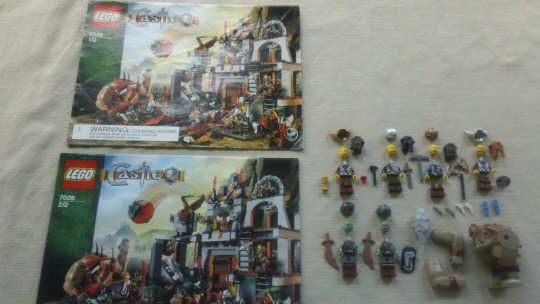
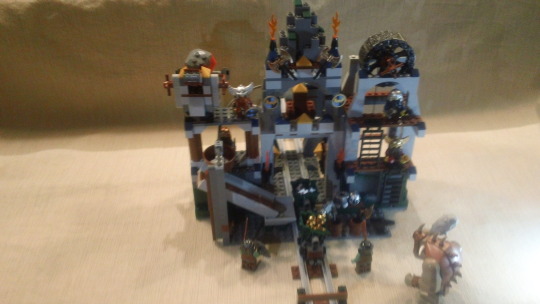






20240601: the History of LEGO Castle day 153. 7036 Dwarves' Mine (2007, 574 pieces, 162 different parts) Dwarves' Mine is a mostly light and dark bluish gray mine front with a track going through large reddish brown doors. This set has seven figures. -One dwarf has a metallic gold helmet with wings, a yellow minifigure head with black scruffy beard and sideburns, a smirk and a dimple, a dark brown beard with two front braid and one back braid, a dark bluish gray torso with dark red arms and yellow hands with a medium brown belt collar and cross-chest belt under light bluish gray leather armor with three disks, and short dark brown legs. Accessories for this minifigure include a pearl gold goblet and a red gem. The helmet, torso, and beard are found in four sets, 7036 Dwarves' Mine, 7979 Castle Advent Calendar 2008, 852293 Giant Chess, and 852702 Dwarfs Blister Battle Pack. The torso is found in an additional four viking sets. -One dwarf has a metallic silver helmet, a yellow minifigure head with a lopsided smirk and reddish brown eyebrows Parts inventory for this set can be found on BrickLink or Rebrickable and a free download of the instructions can also be found under the "instructions" tab on Rebrickable.
#lego 7036#lego dwarves mine#lego castle#lego fantasy era#lego castles#lego#lego history#lego castle history#history of lego castle#lego system castle#lego castle system
0 notes
Text
Exploring the Evolution of Character AI: From Pixels to Personalities
In the expansive realm of gaming and interactive storytelling, the concept of Artificial Intelligence (AI) has undergone a fascinating evolution. While early character AI was primarily concerned with basic pathfinding and scripted behaviors, modern iterations have transcended mere functionality to embody rich personalities and complex decision-making processes. In this article, we delve into the evolution of character AI, tracing its journey from rudimentary algorithms to lifelike companions and adversaries.
The Dawn of Character AI: Simple Scripts and Pathfinding
In the early days of gaming, character AI was rudimentary at best. NPCs (Non-Playable Characters) followed predefined paths, reacted predictably to player actions, and lacked depth beyond scripted interactions. Games like Pac-Man and Space Invaders epitomized this era, where enemies followed set patterns, offering little in terms of strategic challenge or emotional engagement.
Advancements in Behavior Trees and Finite State Machines
As gaming technology advanced, so did character AI. Behavior trees and finite state machines emerged as popular paradigms for defining NPC behavior. These systems allowed for more dynamic responses to player actions, enabling characters to adapt to changing circumstances within the game world. Games like The Sims and F.E.A.R. showcased the potential of these systems, with characters exhibiting lifelike behaviors such as socializing, working, and expressing fear.
Emergence of Dynamic Systems: Procedural Generation and Adaptive AI
With the advent of procedural generation and machine learning, character AI entered a new era of complexity. Procedural generation algorithms enabled the creation of vast, dynamically generated worlds populated by AI-driven entities with unique personalities and behaviors. Titles like Dwarf Fortress and No Man's Sky exemplify this trend, with AI characters exhibiting emergent behaviors shaped by their environment and interactions with other entities.
The Rise of Personalized Experiences: Deep Learning and Neural Networks
In recent years, deep learning and neural networks have revolutionized character AI, enabling unprecedented levels of personalization and realism. These systems analyze vast amounts of player data to create AI companions and adversaries that adapt to individual playstyles and preferences. Games like The Last of Us Part II and Red Dead Redemption 2 employ these techniques to craft deeply immersive experiences where AI characters evolve and react in ways that feel eerily human.
Ethical Considerations and Future Implications
As character AI continues to evolve, so too do the ethical considerations surrounding its implementation. Questions of agency, consent, and representation loom large, with developers grappling with how best to balance realism with responsibility. Additionally, the potential for AI-driven characters to influence player behavior raises concerns about unintended consequences and ethical boundaries.
Conclusion: The Future of Character AI
The journey of character AI from simple scripts to lifelike personalities is a testament to the ever-evolving nature of technology and storytelling. As we look to the future, the possibilities for character AI are boundless. From immersive virtual worlds populated by AI companions that feel like real friends to interactive narratives where every choice shapes the behavior of AI-driven characters, the future of gaming and storytelling is bright with potential.
In conclusion, character ai alternative has come a long way since its humble beginnings, evolving from basic algorithms to sophisticated systems that blur the line between fiction and reality. As technology continues to advance, so too will the capabilities of character AI, ushering in a new era of immersive experiences and interactive storytelling.
0 notes
Text
Drabble Advent Calendar - Decmber 9th
I’m about a week behind, but I’ll get there! Today’s belated prompt is from @clippedionianvowels: Rimmer/Lister: Llama
-----------------------------------------------------
“It’s going to die, you know.” Rimmer leaned over his shoulder, smirking, and Lister sighed. “You’re one to talk.” “I mean it.” Rimmer prodded the red petals. “I don’t know why you’re doing this; you’re terrible with flowers. You’ve killed cacti.” “I like it, it’s Christmassy.” And for all he knew, this could be the last poinsettia in the universe. They’d only found one seed packet. “Why not let Kryten do it?” “I want to do it, all right?” Lister sighed. “It’s just… it’s a little bit of Earth.” A moment, then Rimmer huffed. “Just don’t try to wrap it.”
-----------------------------------------------------
Prompts are still open!
Any fandom, any pairing, open to all, and you can prompt multiple times. Every day until December 24th, a random prompt will be chosen to be written. The prompt drawn on December 23rd will get a double drabble, and December 24th will get a vignette! @roadsterguysblog is doing the same thing over here!
13 notes
·
View notes
Photo

It simply isn't an adventure worth telling if there aren't any dragons.
- J.R.R. Tolkien
Not until the fall of the Roman Empire and the Rise of Christendom does the dragon in western civilization begin to take on the familiar form we know today in bestiaries and myths. It is perhaps the story of Adam and Eve in the old testament and the appearance of Satan in the form of a serpent that first transfixes the medieval imagination. For nearly a thousand years, the dragon represents evil and becomes synonymous with demons. The dragon is also used by medieval knights emblazoned on their shields and standards to strike fear into the hearts of their enemies. Throughout the epics and romantic stories of this period dragons show up to be slain by the virtuous heroes of folklore, legend and religion.
In the epic of Beowulf (ca. 1000 AD.) the great Scandinavian king slays a monstrous fire-breathing dragon and dies in its arms.
Icelandic tales in the Volsungasaga (1250 AD.) transforms the dwarf prince Fafnir into a dragon to be slain by Seigfried.
The Welsh Epic of The Mabinogion (1400 AD.) depicts the great Red Dragon of Wales battling a White Dragon and causing earthquakes.
In the Christian faith Satan routinely appears a dragon to tempt the saints. The Golden Legend (1200 AD.) illustrates St. George and St. Margaret as well as several other saints, confronted by dragons.
By 1500 ad. the mystical apex of catholicism combined with the ever-increasing craft of the visual artists finds the archetypal fire-breathing dragon in its full splendor. This is well documented when Edmund Spenser describes his titanic monster in The Fairie Queene (1590)
After the Protestant Reformation and the advent of the Age of Reason the dragon becomes more a creature of entertainment rather than of spiritual belief. Protestant artists are prohibited from depicting scenes from the bible and the stories of the saints are abandoned as idolatry. Dragons and other beasts take on a decorative nature, and as subjects of classical illustration. During this period it is the first evidence that the dragon is being treated as a fantasy creature.
The 19th century sees a resurgence in the dragon as archeologists, historians and the stories of the “Pre Raphaelite” age are studied and adopted as acceptable subject matter, through Bullfinch, The Brother’s Grim and new translations of the classics and folklore. Throughout this period the dragon stories of the dark past are fodder for artists and writers alike. By the second half of the nineteenth century the neo-isms (Neoclassical, neo-gothic, neo-egyptian, neo-romanesque) of the beaux-arts academic style return to using the dragon as a decorative embellishment.
With the dawn of the Industrial Age twentieth century science and technology usurps romantic notions of the arts, pushing the stories of dragons into the genre of mythology and the realm of children’s stories. Painting and literature had embraced Realism and analytical minimalism throwing off all superstitions of the past to try to make a New kind of art. Any depiction’s of dragons during this period (and there are few) become an outward representation of the artist’s inner psyche. Psychology has replaced the dragon with the Id and the Ego.
By the 1970’s, however the art world was ready to once again re-embrace spirituality, mythology and the dragon. Post-Modern artists found the writings of J.R.R. Tolkein and Joseph Campbell. The mythologies they had drawn from had a renaissance.
In 1976 TSR introduced Dungeons and Dragons to a world hungry for fantasy and monsters, becoming a popular phenomenon. McCaffery’s Dragonriders of Pern 1970, Dragonslayer 1981 were all introduced to a mesmerized audience. Since then the dragon has entered into the popular consciousness in a way not seen since the Middle Ages. Everything from Harry Potter to World of Warcraft and Skyrim have adopted the dragon as their go-to monster to inspire awe and magic.
What is it about the dragon that has captivated us for all of civilization? Is it the sheer power of nature that cannot be tamed. Is it a psychological metaphor for primal fear? Is it perhaps a innate memory of our long lost primitive prehistory? Whatever the reason, in all cultures around the world the dragon , in all its forms has haunted our minds and our imaginations and will continue to do so in the century to come.
**Medieval artwork of a leaf from Harley’s Bestiary, made from Gerald of Wales’ topography in around 1250–1350AD.
77 notes
·
View notes
Text
Advent 11: Home Alone Cat - Part 1
'Fellas?' the Cat called, trying very hard not to sound worried. His voice echoed around the empty corridor. 'FFFEEEELLLLASS?'
No reply. The drive room was empty. The TV room was empty. Kryten's cupboard only had brooms and mops; and Lister and Rimmer's bunk room was completely and utterly 100% Lister-and-Rimmer free.
'I'm home alone!' Cat wailed. 'Who'll feed me now?'
***
Out of all the Starbug crashes Rimmer had survived and walked away from, he rated this one as by far the worst.
Starbug was burning and Lister was lying trapped under the twisted metal of his chair.
'Quickly, sir-sir!' Kryten urged from where he lay. 'Get-get him out!'
What do you think I'm trying to do?! Rimmer thought irritably.
He moved his feet and legs, but he remained where he was - floating two inches above the floor. Gritting his teeth, Rimmer focused all his mental powers on taking a step forward. His boots gripped nothing and he slid to the left as though he were trying to walk on ice. But it was a step in the direction - well, almost.
He grabbed a dangling pipe and pulled himself forward. Lister was just ahead of him, not moving. Smoke was pouring into the cockpit. How he would get Lister out Rimmer didn't know, but Kryten was right: he had to hurry.
11 notes
·
View notes
Link
Chapters: 21/25 Fandom: Red Dwarf (UK TV) Rating: Teen and Up Warnings: Mentions of Rimmer's childhood Relationships: Dave Lister/Arnold Rimmer Summary: Christmas in deep space is pretty miserable
0 notes
Text
Had a dream that I found some rare Red Dwarf books in a random charity shop. I think the books have been on my mind since seeing Dan gift Ashens that trivia book as part of this year's advent.
3 notes
·
View notes
Photo

Day 2 of the 2021 Hubble Space Telescope Advent Calendar, one of 25 photos (eventually). This image of the Helix Nebula shows a fine web of filamentary "bicycle-spoke" features embedded in a colorful red and blue gas ring. The portrait offers a dizzying look down what is actually a trillion-mile-long tunnel of glowing gases sitting about 650 light-years away. The fluorescing tube is pointed nearly directly at Earth, so it looks more like a bubble than a cylinder. A forest of thousands of comet-like filaments, embedded along the inner rim of the nebula, points back toward the central star, which is a small, super-hot white dwarf. The tentacles formed when a hot "stellar wind" of gas plowed into colder shells of dust and gas ejected previously by the doomed star. (NASA, NOAO, ESA, the Hubble Helix Nebula Team, M. Meixner, STScI, and T.A. Rector, NRAO)
27 notes
·
View notes
Photo

November 23rd is...
Cashew Day - The cashew nut is a seed harvested from the cashew tree. The tree originated in Northeastern Brazil. However, it is now widely grown in tropical climates for its cashew apples and nuts.
Eat A Cranberry Day - The word cranberry comes from “craneberry”; first named by the early European settlers in America who felt the expanding flower, stem, calyx, and petals resembled the neck, head, and bill of a crane. Found in acidic bogs throughout the cooler regions of the northern hemisphere, cranberries are a group of evergreen dwarf shrubs, or trailing vines. The fruit of the cranberry plant is a berry that is larger than the leaves and is initially white but when ripe, turns a deep red.
Espresso Day - The word espresso in Italian means ‘quick in time.’ Before the advent of the espresso machine, espresso was simply a coffee expressly made for the person ordering it. It was also made with recently roasted and freshly ground beans. The cup was brewed shortly before serving. In the late 1800s, this practice was commonplace in cafés and restaurants. While today’s espresso maintains the freshness quality, it has undergone a transition in meaning. We’ve come to know espresso as a highly concentrated brew served in smaller quantities. We may also use espresso as a base for other delicious coffee creations.
Fibonacci Day - Fibonacci is an Italian mathematician who is also known as Leonardo of Pisa and Leonardo Fibonacci. Some say Fibonacci invented the Fibonacci sequence. This pattern of counting means that each number is the sum of the previous two. (0,1,1,2,3,5,8,13, etc.) Computer data storage and processing uses this number sequence today. The sequence is also useful in the trading of stocks and architecture. Another unexpected place we find the sequence is in nature. DNA patterns and hurricanes contain patterns showing this sequence. Math and science classes refer to the Fibonacci sequence as “nature’s secret code” or “nature’s universal rule.” Additionally, the number sequence is tied to the golden ratio and the golden triangle.
Wolfenoot - Celebrates both the spirit of the wolf and kindness. It’s also a day that encourages people to be kind to animals, especially dogs as they are descendants of the wolf. Many people in the United States are gearing up for Thanksgiving. But one holiday you may not have heard of yet is called Wolfenoot (pronounced wolf-a-noot). This holiday revolves around a wolf-like Santa clause that brings presents to humans. This “spirit of the wolf” especially likes those who are kind to dogs.
24 notes
·
View notes
Photo

Bhikshanta Shiva - Supreme Naked Beggar
✨
A comprehensive description by Yogi Ananda Saraswathi:
BHIKSHATANA is a manifestation of Lord Shiva as the Supreme Naked Beggar. Bhikshatanar is the murti who asks for alms. He is smeared in white ash, forehead bears the Tripundra, the Shaiva tilaka composed as three horizontal lines with red dot in the middle; with good omen in eyes, fingers with grass to the right, with Trishula and Kapala in the left hands, nice paduka in feet, with dangling red matted hair, jatamandala or jatabhadra, disheveled matted locks, moon on head, patta, ornamental head band, deer-mrigam in the right hand, a vessel for alms in the left, with bulged belly, multiple necklaces, armlets, elbow bands, bracelets, snake tied around his waist, white yagnopavita worn across the chest, followed by love-sick women, so much describes Bhikshatana. Various Puranas describe the backdrop of Lord Shiva taking this manifestation. In the South, Bhikshatana has a different depiction. The front arm is stretched out and downwards. It is holding a bit of grass or another plant in the kataka gesture, near the mouth of a deer who is leaping playfully by his side. The back arm is raised holding a Damaru. The front left holds a Kapala for begging. The back left hand holds a Trishula decorated with peacock feathers. The left leg is firmly rooted in the ground while right is slightly bent. He wears the wooden sandals, the Paduka or is barefoot. His attendants, the ganas and women, often seven in number eager to embrace him, follow. These women are shown to have their cloths slipping from the loins symbolizing lust. This depiction shares much of Bhairava iconography and is linked to the forest legend. This begging iconography is also described in the Satarudriya. It is symbolic of a sustainer of the universe and life-sustaining food. Again this is uniquely from the ascetic Kapalika and Pashupata sects. Images of Bhikshatana are found throughout South Indian Shaivite temples and almost unknown in Northern Indian. Near naked, the phallus is covered either by a tiger skin loin cloth or heavily ornamented as a cover. UPADESA UNDHIYAR: Sri Muruganaar’s Tiruvundyar reached up to Verse 70. As Muruganar was translating this story to Tamil he stopped at the part where Siva is to teach the rishis. Since this portion was to be in the voice of Siva as the Mahaguru, he wanted Bhagavan Ramana to complete this portion. In Murguna’s eyes, Bhagavan was a manifestation of Siva Himself. Bhagavan was compassionate to write the remaining portions. These verses narrate Lord Siva enlightening the ascetics of the Daruka Forests. As such Verses 70-137 was sung by Bhagavan. This culminated as 37 verses in Upadesa Undihyar. It was later translated in sanskrit as Upadesa Saram. DARUKAVANAM FOREST: The background story of Daruka or Darukavanam Forests is this. While the Puranas describe the householder ascetics life, their tapas shows that they were following the path of ‘kamya karma.’ This mean one emphasizes on deeds and performing rituals. They were performing tapas for a long duration and prayed to Siva. They were staunch ritualists who believed that rituals karmas were the way to ultimate Bliss. They exhibited their ignorance by performance of various kinds of yagas and yagnas –sacrificial rites to obtain siddhis – powers for both this world and the next. They had become intoxicated by the use of mantras, yantras and tantras techniques. ‘Karma alone is of foremost importance; even God cannot prevent them from yielding fruits’ was their arrogant attitude. So they stopped worshiping God. They were not to realize that, whatever be the deeds, is there One Who provides the doer with the fruits? How can inanimate deeds automatically give fruits. Not realizing these facts, the rishis pursued their dogma of karma. These paths are prescribed by the Purva Mimamsa school which concerned with the interpretation and practice of Karma Kanda. This portion of Vedas relates to rituals and ceremonial rites. In all His compassion, Lord Siva appears to purify their minds by teaching the ultimate truth. This was to make them realise that actions are born out of ignorance of one’s own nature. Knowledge is the only way to the Ultimate Reality. So Lord Siva’s makes his advent as a Bhikshatanar-beggar. Vishnu accompanies as his wife, Mohini, glamorous girl. In this form the Lord is naked but quite enchanting. His appearance is Urdhvalinga, with an erect phallus. So was Mohini. The Naked Lord came to the street of the rishis to get alms and Mohini followed Him. The rishis are attracted to the enchanting Mohini and started following her. They forgot all about their karmas. On the other hand the rishi pathinis, the wives, are attracted to the robust-built Siva. They forgot what they were doing, allowed their clothes to fall off and followed Him. They were also dancing, singing and love-sick. The rishis get upset. They started to have double standards. While they were in pursuit of Mohini, they got upset with Siva as their wives have lost their virtue by following a Naked Beggar. So they uses all the mantras and ritualistic powers to destroy Siva. They performed abhichayagam which will produce bad effects. They directed snakes, demons, tigers, fire and drum that came out of the yagna fires against the Lord. Siva was beyond defeat and made them all as ornaments. He peeled off the skin of the tiger and wore it round his waist; caught hold of the ball of fire in his left hand and held it aloft and calmed the serpent and wore it round his neck as an ornament. By now, Lord Shiva had begun to dance in joy. This irritated the rishis because the wives started to enjoy the dance. So they set up the monster against him, He dwarfed the monster, stood on it on one leg and continued his dance. Vishnu and the others were charmed by this Ananda Tandava - Joyous Divine Dance of the Lord. Finally the forest dwellers realise Siva’s true nature when Anusuya, the wife of sage Atri enlightened the sages that the Beggar couple was none other than Shiva and Vishnu. PASHUPATA: Shiva later returned with Parvati and eventually revealed his Supreme form and exalted the Pashupata vow – by which a man restrains his passion, becomes celibate, and roams naked smeared with holy ash, declaring that such a lifestyle would lead to moksha. The forests prostrate at his feet and beg for knowledge. Lord Siva led the ascetics from their low level spiritual maturity. They had to be elevated gradually from the grosser methods of spiritual practice such as puja, japa, dhyana and pranayama towards the refined method of Self-enquiry. Siva takes His true form and taught that “there is only one thing here that is called the Self or God or Brahman. Whatever is seen in this dual world is only Consciousness and not different from it, and that perfect Blissful Consciousness You are. KURMA PURANA: Brahma declares that he is the Supreme Creator of the Universe in the council of rishis. Lord Shiva appeared as an infinite pillar of light and challenged Brahma. The council accepts Siva’s superiority. Brahma remains obstinate and upsets Siva. He transforms into a terrifying Bhairva and cut off one of Brahma’s heads with the flick of his fingernail. This form is depicted as Brahmashirascheda Murti. Brahma’s death is redeemed by his lifetime asceticism. Thereafter Brahma accepts Shiva’s superiority. The story does not end here. The Shiva Purana, Matsya Purana and Skanda Purana give different reasons for the decapitation. The reason given is Brahma’s lust and incest for his daughter. However all the Puranic versions point to Brahma’s head getting stuck to Bhairava Shiva’s left palm. KAPALIKA: It is also a sin to kill a Brahmin as this is Brahmahatya or brahamnicide. To expatiate the sin of brahmahatya, Shiva as Bhikshatana, had to perform the vow of a kapali, wondering as a naked beggar with the skull as the begging bowl. He wanders the three worlds begging from door to door accompanied by bhutas. Here again women are attracted to Bhikshatana despite his appearance, singing and dancing. He finally reaches the Daruka forest. There he shocked the sages with his ‘lewdness and nudity’ and also tempts the sage’s wives. But Bhikshatana-Shiva made them realize his greatness after they confronted them. There are various other plots related to his wanderings. After the Daruka forest encounters, Bhikshatana reaches Vishnu’s abode. The gatekeeper, Vishvaksena refuses entry. He is killed and the corpse is impaled on Shiva’s Trishul. This is an additional sin. Kankala Murti is the form of Siva with a corpse on the Trishula. He enters Vishnu’s abode to beg for food, where one version states that Vishnu offered his own blood. The other version is Vishnu cutting an artery on Bhikshatana’s forehead and a stream of blood spurting into the begging bowl. Vishnu then directed Bhikshatana to make a sacred trip to Varanasi to expatiate his sin. At Varanasi, Brahma’s skull falls off Bhikshatana at a place called Kapala-mochana. It means ‘liberating from the skull’ and Vishaksena’s corpse also disappears from the Trishula but he is revived to life by Shiva. Now Bhikshatana enters the sacred ponds of Varanasi. He then casts off the Bhikshatana form to return to Kailash. KAPALESHVARA: This legend in the Skanda Purana narrates that Bhikshatana appears as a naked, fierce Kapali beggar. In a sacrifice hosted by Brahma, Bhikshatana appears and begs for food. He is driven away by Brahmin because they find a begger unfit to attend sacrificial rites. Bhikshatana throws his skull begging bowl on the ground and the brhmins throw it out. But other skulls appear in its place. Consequently hundreds of skulls appear and pollute the sacrifice. This compels Brahma to promise that no sacrifice would be complete without invocation to Kapalshvara-Shiva, the Lord of the Skulls. Yogi Ananda Saraswathi
#Shiva as Bhikshatana#Supreme mendicant#Supreme Beggar#Legend of ascetics in the Daruka Forest#Bhagavan Sri Ramana Maharshi#Sri Muruganar#Upadesa Undiyar#Upadesa Saram
33 notes
·
View notes
Text
Cerebus #16 (1980)
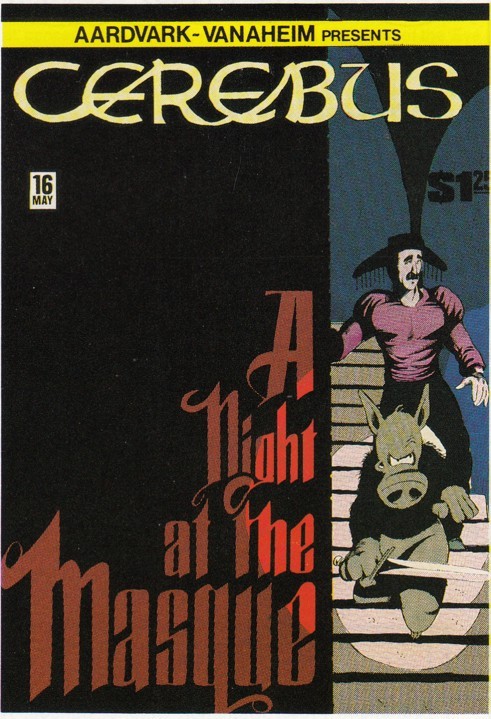
Cerebus is going up the stairs while Lord Julius is going down them. In the same direction.
Cerebus is often touted as the greatest independent comic book of all time (for various reasons) but I'd like to point out that Elfquest told an incredible story with beautiful art in just 20 issues as opposed to 300. Plus it had an elf orgy. Also, I know it continued on after the first 20 issue story arc but we can ignore the rest of the story because there was never another elf orgy and also the rest of the series concentrated too much on Skywise's fear of dying which was totally valid but was often used as a foil to make Cutter seem braver and more loyal to his wolf roots but really just showed he was stubborn and dumb and totally didn't fuck as many elf maidens as Skywise did. Cerebus does have some sex in his comic book but since the first sex he has is when he rapes Astoria, I don't think anybody was really clamoring for any more of that. I mean, sure, some people were! I didn't mean to erase the sickos and perverts out there. Sorry, jerks! I'm sure the "A Note from the Publisher" bit by Deni seemed like a good idea when starting out on a harrowing self-publishing journey like that of Cerebus. But it quickly became a space where Deni just says, "Self-publishing is fraught with hardships and also this is a really good issue! I won't spoil it! Goodbye!" I won't be sad to see the divorce happen! That's an okay thing to say because it already happened, right? It's not like my wishing for the end of their marriage in 2020 somehow brought about the end of their marriage in the early 80s. Is it? I never took a college course on cause and effect so who the fuck knows? Unless that Critical Literary Theory class was about that?! Oh my God! I think I understand it now! Dave's finale to the "Swords of Cerebus" essay that has been broken up over the last three issues describes how he was consciously drawing the Eye of the Pyramid cult leader's gigantic penis while drawing the snake. Sorry to report, though, that he's being sarcastic. Apparently Dave is above using phallic imagery to make a point about patriarchal themes. Only fucking hacks do shit like that! Take that, whoever wrote fucking Beowulf!

Even if Sim can't see the humor in everybody assuming he made a giant snake dick joke on purpose, he can still be extraordinarily funny with the least of materials.
This issue takes Cerebus to his first fancy dress party (that's a costume party for all of you people who aren't British (which is also me but only because I was born a citizen of the United States of America who didn't have a choice but knew it was a huge mistake as I was learning about Monty Python's Flying Circus and Dave Allen at Large in elementary school and The Young Ones in junior high and Red Dwarf in college)). Cerebus changes out of his vest and puts on his costume: a furry black jumper (that's sweater for all of you people who aren't British (which is also me but only because I was forced to watch mostly American popular entertainment until the advent of YouTube and now I mostly just watch Taskmaster over and over (by the way, is Taskmaster as good for people who don't know all of the "contestants" or do I enjoy it more because I recognize and like almost all of the people on the show?)). Lord Julius is dressed as an, um, a, uh, Estarcion matador? I have no context in which to guess what he is.

Certain people like Cerebus because he says what's on his mind. I purposefully used the passive voice here so you can't prove one of those people is me.
Lord Julius has a follow-up joke that leaves the reader thinking, "I guess all Pavrovians are fat?" That's Dave Sim continuing his work on Estarcion continuity! Remember how Pavrovians are the, um, you knows of Estarcion! You know the nationality I'm thinking of! The ones that are all the things people usually find insulting! Come on, you know who I'm talking about. The dumb fat arrogant stupid naive gullible ones! Yes, that's it! Americans! Try to remember Dave is Canadian. You have to think of Americans through Canadian eyes (which are the equivalent of smart, cynical Americans)! E'lass and Turg have gotten tickets to The Festival of Petunias so they can steal the Wyndmel Diamond. They're the duo composed of a giant muscular man and a little bitty shrimpy guy who last encountered (and were beaten by) Cerebus in Issue #6. E'lass is dressed like some kind of small dirt dwelling creature so I hope Cerebus gets offended by his costume and stabs him in the throat. There isn't enough random slaughter in this book about barbarians.

I haven't wanted to fuck a fish this badly since The Littler Mermaid.
I suppose I could have said "since Splash" in that last caption to seem more normal and less perverted but then you'd know I was lying. The assassins make a move on Lord Julius but Cerebus comes up with a plan to stop them that involves inducing the Palnu elite to throw herring-and-onion dip at them. Is that a parodied scene from Duck Soup or Conan the Barbarian? In the confusion, the lead assassin slips out through a secret door and E'lass, having just stolen the diamond and becoming increasingly paranoid that somebody saw him, slips through it as well. Cerebus and Lord Julius follow, having noticed the assassin but not E'lass. Most of the pursuit's tension comes from E'lass believing Cerebus remembers him and is now going to use the excuse of this new crime to murder him. It's more tense than I've even described because I really need Cerebus to murder somebody in this Swords & Sorcery book already. Reading this book waiting for a murder is like firing up a porn video on your laptop with your dick in your hands and realizing after five minutes that the video is almost over and was just a teaser for a pay porn site. Cerebus threatens to quit his job just before battling the assassin so he can negotiate a term of 8 bags of gold and a horse in exchange for killing the assassin as a pension before he goes. Julius agrees and Cerebus takes out the assassin with a rock to the head. I mean, I guess it's a murder so yay? But I was really hoping for some stabbing. Meanwhile E'lass lives through the cliché of the criminal whose paranoia gets the better of him and he tosses the diamond into a huge pit so he doesn't get caught only to discover that they never knew he took it anyway. Everything is wrapped up quickly and thoroughly with Cerebus given money and motivation to move on from Palnu. Dave complained about his heavy use of cliché in this Palnu trilogy and I have to say I agree with Dave. But I only agree with Dave on this point! Don't take that out of context and start raving on Twitter that Grunion Guy agrees with Dave's Issue #186 rant about girlfriends being illogical which is also secretly a rant about a guy who needs to get laid so badly he puts up with partners he probably wouldn't even be friends with and then finally just decides orgasms are evil and religion is super awesome but only if you smash all three People of The Book religions into one bland mash paste of ancient dogma. In the epilogue, Lord Julius receives a letter from his niece Jaka in which she expresses delight in possibly seeing Cerebus again. I guess Dave learned from Howard the Duck that comic book nerds really love for their anthropomorphic heroes to be fucking statuesque women. Perhaps every guy develops a fetish of being with a woman whose breasts are at head level due to being hugged constantly by their female relatives when they're ten years old. Deni's brother Michael's first installment of the "Aardvarkian Age" essays appears in this issue. It gives more details to the various nations of Estarcion and their inhabitants' culture, ruling styles, and brutality of their armies. I thought I'd be more interested in this than I actually wound up being. Maybe I thought it would be funnier? Instead, it's just a bunch of facts about made-up kingdoms to make them sound more believable by making them more like European countries in the Middle Ages. If this entire bit were just lifted from a history of Europe with the names of actual countries replaced by Estarcion countries, I wouldn't even notice. Mostly because I know nothing about European history. As I've always said, "Those who know about European history are doomed to repeat it, boring every single other person at the cocktail party." Dave apologizes for the quarter price increase of the comic book in the Aardvark Comments pages. Why, I hadn't even noticed! Probably because this is the Biweekly reprint issue and I purchased it as a collection off of eBay. Some people write in and discuss how Cerebus is a very fine and funny comic book. I nodded along in agreement as I read the letters. I only touched my private area twice while reading and neither time was for pleasure. The most surprising thing about "The Single Page" is that it clearly states who the comic was authored by: Kent Featherly. I don't know why so many of these single page comics aren't more clearly labeled. Isn't part of the reason for having them exposure for the artists drawing and writing them?! Not putting an effort to let a large audience know who you are and how they can read more of your work just sounds like something I would do. By the way, you should play this game I wrote, Starship Troopers: The Game. You can find it on the hard drive of my laptop. Cerebus #16 Rating: B. Look, it was funny and well drawn and all that. But even Dave said it relied too heavily on cliché plot devices. I've got to lower the grade when even the author points out some of the story's flaws! And I'd probably have come to the same conclusion without having been influenced by Dave Sim because I'm like the best Internet comic book critic who isn't a critic and isn't actually reviewing comic books. Also I almost forgot this evidence: I'm a Grandmaster Comic Book Reviewer! Nobody else can make that claim and if they do, they're plagiarizing me and I'd like you to point them out to me so I can send them a threatening email in which I pretend to be my own lawyer who is really good at suing dumb-dumbs.
2 notes
·
View notes